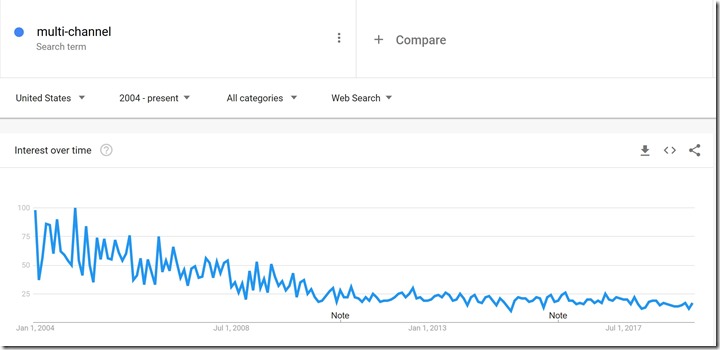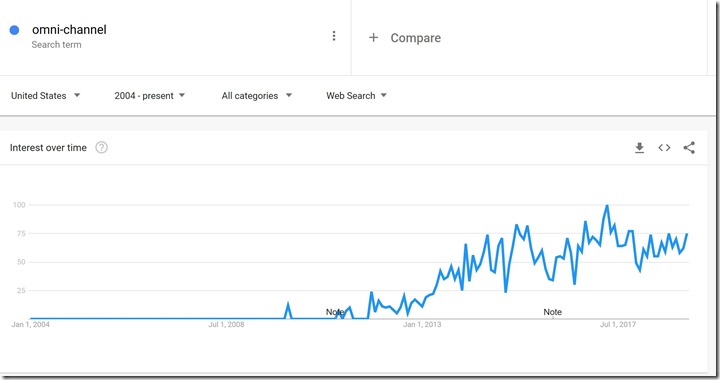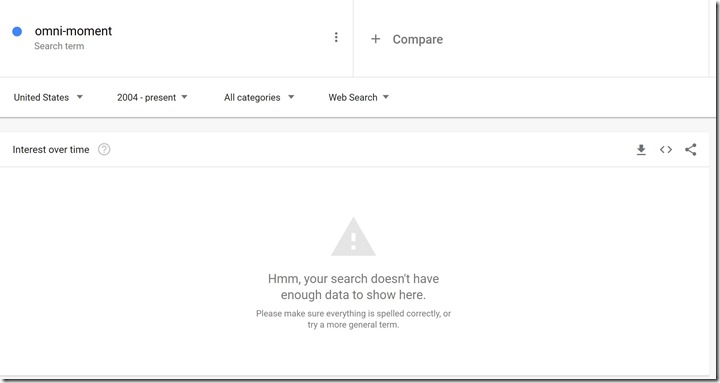Starting university in the early nineties gave me a unique position to appreciate the modern evolution of technology. The internet in the public domain was still in its infancy. I was one of the first people I knew to have an email address and had to explain what email was to many of my friends. ICQ was five years away so messaging was done via ‘telnet’ where you ‘dialled’ someone’s IP number to chat.
Browsing was text based with hyperlinks and there was no search engine (AltaVista was three years away). You simply discovered pages of web links through word of mouth.
This was a time when customer service was delivered through three channels: face to face, phone, and fax. We have come a long way.
The Advent of Multi-Channel
People do not really talk about multi-channel any more. It was big for customer service and for marketing and, while it could be argued even our pre-internet customer service was multi-channel, my recollection is the term only came into mode when linked to internet channels.
It was also the beginning of a shift in considering what customer service was for. Before this time, customer service was little more than part of the product/service offering. If a company offered three services, each department was responsible for customer service, and there would be three customer service functions. I recall a prominent American bank at the time having literally a dozen different fax numbers for different divisions (the only reason I remember this is because I once flooded all the fax numbers when the bank was slow at refunding an erroneous monthly charge. Enquiry processing across the bank came to a halt in what was, arguably, a pre-internet Denial of Service attack).
With the introduction of channels like email and online forms, came the shift to considering the customer’s experience. It made sense for the customer to choose the most convenient way to reach the organisation and not the other way around.
The outstanding problem was minimal cross-communication. Multi-channel meant multiple ways for the customer to get service but each channel was still a separate experience. Switching channels often meant starting again and customers were still bounced around departments for more complex issues.
Progression to Omni-Channel
Omni-channel, as you can see from the Google Trends graph, started becoming a thing about five years ago. Thanks to the online revolution, enterprise-level CRM systems became affordable for all. This provided a centralized hub for all enquiries. You could email about an issue, follow up with a phone call, and then go to the company’s physical service counter and all interactions would be recorded in the same system and available at the click of a button.
While multi-channel gave consumers a choice of communication channel, onmi-channel took it one step further and ensured a consistent experience or, at least, a consolidated one.
With most CRM systems, a rudimentary omni-channel system can be set up relatively easily. In my last project for a major university, whether the student asked their question face to face, via phone, email, or online form, everything became a Case record in Dynamics. In an omni-channel system, the customer gets to use the channel which makes sense for them and their enquiry. For the company, the channel does not really matter as a centralized CRM system means all enquiries are treated consistently. A true omni-channel system also removes “answer shopping”, common in multi-channel systems.
The Future is Omni-Moment
The core assumption in an omni-channel system is the customer chooses a channel for an enquiry and sticks with it for the duration of that enquiry. Focussing further on the customer experience, the nature of the enquiry may require multiple channels to be engaged as part of the one interaction. Let us consider an example of opening a bank account.
In the multi-channel experience, a customer calls to find out about the procedure. They do not quite get the answer they are after, so they call back to get a different agent. They then visit a bank branch to collect the right forms. They go home, to fill in the forms. If they need to clarify something about the form, they either call or revisit the branch. There is no guarantee that the advice they get from these channels will be consistent.
The customer hunts down a notary and has their identification documentation validated. Once completed, the forms are faxed. Finally, once the processing department has informed the local branch that the account is open, the customer returns to the bank branch to provide a signature and collect a bank card.
Every step in the process is an isolated channel with the customer being expected to bring it all together in what was often a frustration and time-wasting experience.
In the omni-channel world, the customer goes online to find out about the procedure and there is an online form. If the customer has a question about the form, they can call or browse the web site. As both channels are pulling their information from a centralized knowledge management system, the answers will be consistent (and hopefully comprehensive).
Identification documentation is again notarized and once the form is completed, with notarized documentation attached, the application is processed and, with signatures being a thing of the past, a card is sent in the mail.
In the omni-moment experience, the customer goes online to find out about the procedure. The web site recognizes the intent and provides the option of a chat bot to assist. If the customer’s enquiry cannot be answered by the web site or bot, the interaction is escalated to a human. The agent offers to share screen and walk the customer through filling in the online form. Using video conferencing, the agent can verify identification on the spot without the need of a notary. Forms are completed and the account is opened immediately ready for online use. A bank card is again sent in the mail.
As you can see, the seamless integration of people, process and technology, make for a delightful customer experience. A process which took a week in the multichannel world, is completed in half an hour in the omni-moment world.
The Evolution of KPIs
As the way we interact with customers has changed, so too must our KPIs. Here are some classic call center KPIs which I consider irrelevant (or at least very misguided) in the modern customer service center.
Average Handling Time
Even back in the days of call centers, I was not a fan of this measure. It encouraged agents to open a call and immediately hang up to lower the stat. It is focussed on productivity, often at the expense of the customer experience.
If an agent spends 20 minutes assisting one customer to open up a bank account and 30 minutes with another, why is this a problem? If one agent is terse and goes through the form quickly, is this better than someone who actually takes the time to make sure the customer knows what is going on?
Average Time in Queue
There really is no excuse for waiting in a queue on the phone these days. Assuming a customer insists on exclusively using the phone, a call back service should be standard procedure. In an omni-moment world, there should be no queue and all queue measures are irrelevant.
Cost Per Enquiry
It is good to have visibility on costs but this should not be managed at the expense of the customer experience. In the early days of online channels it was realised these were much cheaper to operate than traditional channels. In some cases the customer experience was worsened for the traditional channels to encourage people to go online. This is management in the absence of strategy and is disastrous in the long term.
What is the Purpose of Customer Service?
The ultimate measure of customer service should be customer satisfaction. In my opinion this should be sought directly through surveys rather than assumed through measures such as Average Handling Time (a short call is not necessarily a good call). I can see value in measuring First Call Resolution (as confirmed directly with the customer) as this should be the ultimate goal of customer service. However, it need to be modified so it covers all channels across the customer experience, not just the phone component (assuming a phone is even involved).
While in a pre-multi-channel world, customer service was seen as little more than a necessary evil for selling a product or service, in an omni-moment world, the minimum standard is having the customer ask no more than once and be satisfied every time they make an enquiry. In fact with machine learning, in many cases, it should be possible to anticipate customer need and frequently achieve ‘ask never’ for existing customers.


